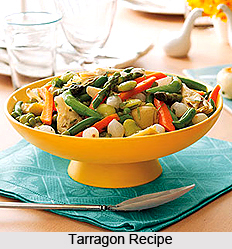 Botanical names: Artemisia dracunculus Linn.
Botanical names: Artemisia dracunculus Linn.
Family name:Compositae.
This spice is not popular in India, though it grows in certain places in India in wild state. Only recently it is gaining popularity due to western influence. However, it is well known in Europe as a spice and used for flavoring foods.
The dried leaves and flowering tops of the plant constitute what is known as Tarragon or Estragon, so well known to the connoisseurs the world over for its unusual intriguing flavor. Sometimes, it is called `French Tarragon,` its aroma is warm, aromatic and reminiscent of anise.
The dried leaves of Tarragon were found to contain:
Moisture:4.7%
Protein:24.2%
Fat:7.3%
Fiber:6.8%
Carbohydrates:44.7%
Total ash:12.3%
Calcium:1.3%
 Phosphorus:0.31%
Phosphorus:0.31%
Iron:0.034%
Sodium:0.07%
Potassium:3.2%
Vitamin A (carotene):175 I.U./100 gram
Vitamin B1:0.2 mg/100 gram
Vitamin B2:1.34 mg/100 gram
Niacin:8.9 mg/100 gram
Vitamin C (ascorbic acid):12 mg/100 gram.
Calorific value: 365 calories/100 gram.
The herb on steam distillation yields about 0.3% volatile oil, which is actually responsible for the aromatic aniseed like odor. Methyl chavicol is the chief constituent of the volatile oil and phellandrene and ocimene are additional constituents.
The spice is used for flavoring vinegar, popular as `Tarragon Vinegar`, pickles, prepared mustard, and to a limited extent for flavoring of soups, salads, meat dishes, certain cheeses and vegetables.
The aromatic leaves are credited with aperient, stomachic, stimulant and febrifuge properties. Therefore, they may be used for manufacture of herbal medicines.




















